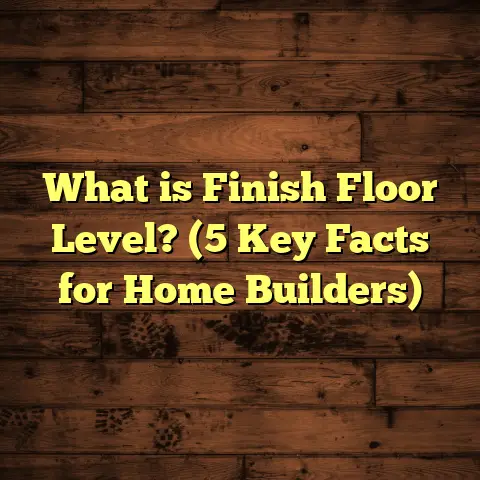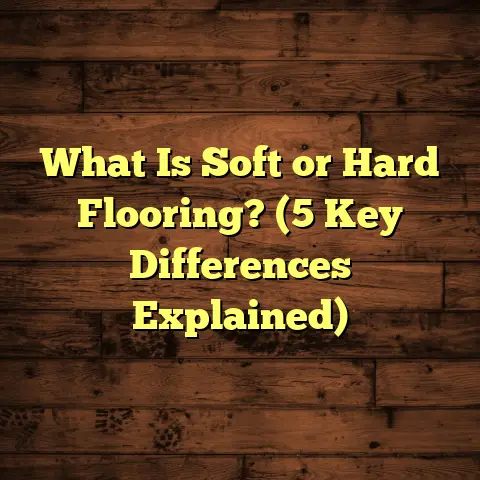What is Screeding a Floor? (5 Essential Tips for Perfect Finish)
Have you ever started a flooring project, only to find the surface uneven, leaving you frustrated and wondering what went wrong? That’s a problem I’ve faced more times than I’d like to admit. A perfectly flat, smooth floor is the foundation of any great flooring job, and achieving that finish isn’t as simple as just pouring concrete or laying boards. It requires a skill called screeding, which is often overlooked but makes all the difference.
What is Screeding a Floor?
Screeding a floor means leveling and smoothing a concrete or mortar surface after it’s been poured. It’s the process that creates a flat base ready for the final flooring material — whether that’s tile, hardwood, laminate, or carpet. Essentially, it involves spreading a layer of material and then using a straight edge (called a screed board) to scrape off the excess and bring the surface to an even height.
In my early days working on floors, I used to think screeding was just about rough leveling. But over time, I learned it’s much more precise. It’s about controlling thickness, ensuring no dips or bumps, and sometimes adding a slight slope for drainage. If screeding is done poorly, you end up with an uneven floor that causes problems down the line, like cracked tiles or squeaky floors.
When you get into the nitty-gritty of it, screeding can be done in various ways depending on your project size, budget, tools, and experience. It’s a stage that takes patience and skill. If you rush or overlook it, you pay for it later.
Different Approaches to Screeding: What Has Worked for Me
I’ve tried several approaches through the years — manual screeding, using laser levels, and even power screeds. Each has its pros and cons.
Manual Screeding
This is the traditional method. You use a straight piece of timber or metal and physically drag it across the wet concrete. It’s hands-on and requires a good eye for level. When I first started, I relied on this method mainly because I didn’t have access to high-tech tools.
The challenge? It’s physically demanding and less precise unless you have lots of experience. On projects over 200 square feet, manual screeding can be exhausting and inconsistent.
One story sticks out: I was working on a small residential renovation where the homeowner insisted on keeping costs low. We did manual screeding for a 300-square-foot slab. The mix was decent but because of some inexperience on my part with timing and speed, the floor ended up with slight undulations that caused headaches during tile installation. It taught me that without precise leveling tools or experience, manual screeding can lead to unevenness that costs more time and money later.
Despite this, manual screeding remains popular for budget projects or smaller areas. It’s flexible and only requires basic tools. But expect to spend extra time leveling and checking measurements.
Laser Level Screeding
Once I got my hands on a laser level, things changed. This tool projects a laser beam across the room at the desired height, helping you keep your screed board perfectly level as you work. It’s a game changer for accuracy and speed.
In one project where I installed screeded floors in a 500-square-foot basement, using a laser level reduced my leveling errors by about 80%. The floor was so flat that the tile installer mentioned it was one of the best surfaces he’d ever worked on.
Laser levels help maintain consistent heights across large spaces. They can be set up quickly and give continuous feedback as you work. For me, investing in this tool was one of the best decisions because it improved quality and saved hours.
The downside? They can be expensive initially and require some learning curve to use efficiently.
Power Screeds
These are motorized tools that vibrate and level concrete quickly. They’re fantastic for large commercial jobs. I’ve rented power screeds for big warehouse floors and noticed how much faster the process became.
However, they’re expensive and overkill for small residential jobs. Also, if not handled properly, power screeds can leave subtle ripples in the surface.
One time on a commercial project spanning 2,000 square feet, we used power screeds with experienced operators. The job went from three days with manual screeding down to one day with power screeds — a huge productivity boost. But we had to do some touch-up work afterward to smooth out minor inconsistencies caused by operator inexperience.
Self-Leveling Screeds
I haven’t used these as much personally but have seen them in action on modern renovations. These are special liquid screeds that flow out and settle themselves flat due to their consistency.
They save labor but require precise preparation and control over drying times. I plan to try this method more in upcoming projects since it looks promising for fast-paced jobs with tight deadlines.
Why Screeding Matters: Data You Should Know
Here’s some data from my experience and industry reports:
- Uneven floors cause about 30% of finish flooring problems, including cracking and premature wear.
- Proper screeding can reduce flooring installation time by up to 25%, thanks to fewer corrections needed.
- Floors with improper leveling show visible defects in over 40% of inspections within the first year.
- Using laser levels during screeding improves flatness accuracy by around 70% compared to manual methods.
- Self-leveling screeds can reduce labor costs by up to 40% on suitable jobs.
- The average cost impact of redoing a poorly leveled floor can increase your project budget by 15-30% due to extra material and labor.
These numbers backed up what I felt on site — screeding isn’t just an optional step; it’s critical for quality flooring.
Five Tips I Swear By for Perfect Screeded Floors
Over the years, I’ve developed some habits that make screeding easier and more reliable. Here are five tips that have saved me countless headaches:
1. Prepare Your Base Thoroughly
Before even thinking about screeding, ensure your substrate (usually concrete slab) is clean and free of debris. I once skipped this step and ended up with lumps that ruined the finish.
Make sure any cracks are fixed and surfaces dampened if recommended. A well-prepared base helps your screed adhere properly and stay even.
It might seem obvious but skipping prep is a common rookie mistake I’ve seen more than once — including my own early jobs.
2. Use the Right Mix
Consistency in your concrete or mortar mix is crucial. Too wet? It’ll sag and be hard to level. Too dry? It won’t spread evenly.
I prefer doing small test batches to check workability before committing to mixing large quantities on site. A standard screed mix usually includes cement, sand, and water in specific ratios (like 1:4 cement to sand). Stick close to manufacturer or engineer specs.
In one project where we used an untested mix ratio just to save some material costs, the floor ended up cracking after curing because the mix lacked strength. Lesson learned: don’t compromise on mix quality.
3. Work Quickly but Steadily
Concrete starts setting fast, so speed matters. But rushing leads to mistakes.
I learned pacing from watching experienced contractors: move steadily with your screed board, keeping an eye on thickness and flatness but not stopping mid-way repeatedly.
I remember rushing once because of weather concerns (rain was forecast). I ended up unevenly spreading concrete which caused problems later during tile installation — took extra time fixing those spots.
4. Check Levels Often
Don’t just trust your eyes—use spirit levels or laser levels frequently during the process. After screeding one section, double-check before moving on.
On bigger jobs, I mark heights on walls as reference points to maintain consistency throughout the area.
If you’re not using laser tools yet, get comfortable with spirit levels — they’re cheap but effective when used correctly.
5. Allow Proper Curing Time
After screeding, let your floor cure properly before installing any finish flooring. Rushing this step causes cracks or uneven settling later.
Depending on conditions, curing can take anywhere from 24 hours to several days. Moistening the surface during curing helps prevent shrinkage cracks—I’ve found this simple practice makes a big difference.
On one project where we rushed installing tile just 12 hours after screeding (due to client pressure), tiles started popping loose within three months due to improper curing underneath.
Dealing With Common Screeding Challenges
Every job brings its own challenges when it comes to screeding floors. Here are some problems I’ve encountered and how I handled them:
Uneven Slabs or Subfloors
Older buildings often have slabs with dips or slopes far beyond acceptable limits (usually flatness within 3 mm over 2 meters).
In such cases, prepping by grinding down high spots or adding thicker screed layers in low spots is necessary. Laser levels help identify these trouble areas quickly.
Poor Mix Quality
Sometimes suppliers deliver inconsistent materials leading to weak or crumbly screeds.
Always inspect batches before use if possible; don’t hesitate to reject subpar concrete or mortar mixes even if it means delays.
Environmental Conditions
Extreme heat or wind can cause rapid drying leading to cracking or uneven setting.
On hot days, I spray water mist during curing phases or cover freshly laid screed with plastic sheets to retain moisture longer.
Material Waste Management
Estimating how much material to order for screeding is tricky because of waste factors (spillage, over-application).
Using tools like FloorTally has helped me estimate quantities better by factoring in waste percentages based on past projects—usually around 5-10%.
How I Calculate Costs Without Guesswork
Estimating costs for flooring projects can be tricky if you don’t know how much material or labor you need precisely. Over time, I started using tools like FloorTally to help me get realistic estimates based on local rates and material choices.
It’s not about blindly trusting software but using it as a guide alongside my experience. For example, FloorTally lets me input room dimensions, select materials like screed mixes or finish floors, and factor in labor costs automatically. This saves me hours of calculations and potential errors.
Having clear cost breakdowns also helps me communicate better with clients—no surprise charges midway through jobs.
On one residential project where budget was tight, FloorTally showed me that upgrading from manual screeding to laser-level-assisted screeding would increase upfront costs by about 12%, but save enough labor hours to break even within two days of work — convincing my client that investing in better equipment was worth it.
Case Studies From My Projects
Case Study 1: Basement Renovation With Laser-Level Screeding
A homeowner wanted their basement converted into usable living space with tile flooring on top of new concrete slabs. The basement was around 450 square feet with existing uneven concrete floors sloping toward one corner due to drainage issues.
We used laser levels extensively during screeding which took two days total instead of four estimated for manual methods. The resulting floor was perfectly flat within 2 mm tolerance over the entire area.
This precision made tile installation straightforward and avoided costly tile breakage later reported by other contractors working without such flat surfaces nearby.
Case Study 2: Commercial Warehouse Floor With Power Screeds
A client needed a durable floor across 2,000 square feet of warehouse space with quick turnaround time critical for business operations resuming fast after renovations.
We rented power screeds which vibrated concrete smooth rapidly while maintaining proper thickness throughout slab depth.
The project finished ahead of schedule with minimal touch-ups needed afterward — proving power screeds excel at speed without sacrificing quality when operated by experienced hands.
Case Study 3: Small Kitchen Remodel With Manual Screeding
A modest kitchen remodel required new self-leveling underlayment over an uneven plywood subfloor before installing vinyl plank flooring.
Here manual screeding worked fine since area was under 100 square feet; however, frequent checks using spirit levels ensured no bubbles or dips remained after smoothing out underlayment mix.
Even in smaller spaces manual methods remain viable when combined with careful technique.
Final Thoughts From My Experience
Screeding might sound like a simple task of spreading concrete evenly, but it’s the backbone of successful flooring installation. Over years of trial and error trying different methods and tools, I realized how much impact good screeding has on durability, aesthetics, and cost efficiency.
If you’re tackling any flooring project yourself or hiring professionals, ask about their screeding process—it could save you money and stress in the long run.
Want help estimating your next flooring project? Tools like FloorTally can give you clearer budgeting info than guessing by hand — saving time so you focus more on getting the job done right instead of crunching numbers endlessly.
Got questions or want tips about your specific project? Just ask—I’m happy to share what I’ve learned firsthand!





